TOYOTA AYGO 2012 Owners Manual (in English)
Manufacturer: TOYOTA, Model Year: 2012, Model line: AYGO, Model: TOYOTA AYGO 2012Pages: 368, PDF Size: 16.94 MB
Page 91 of 368
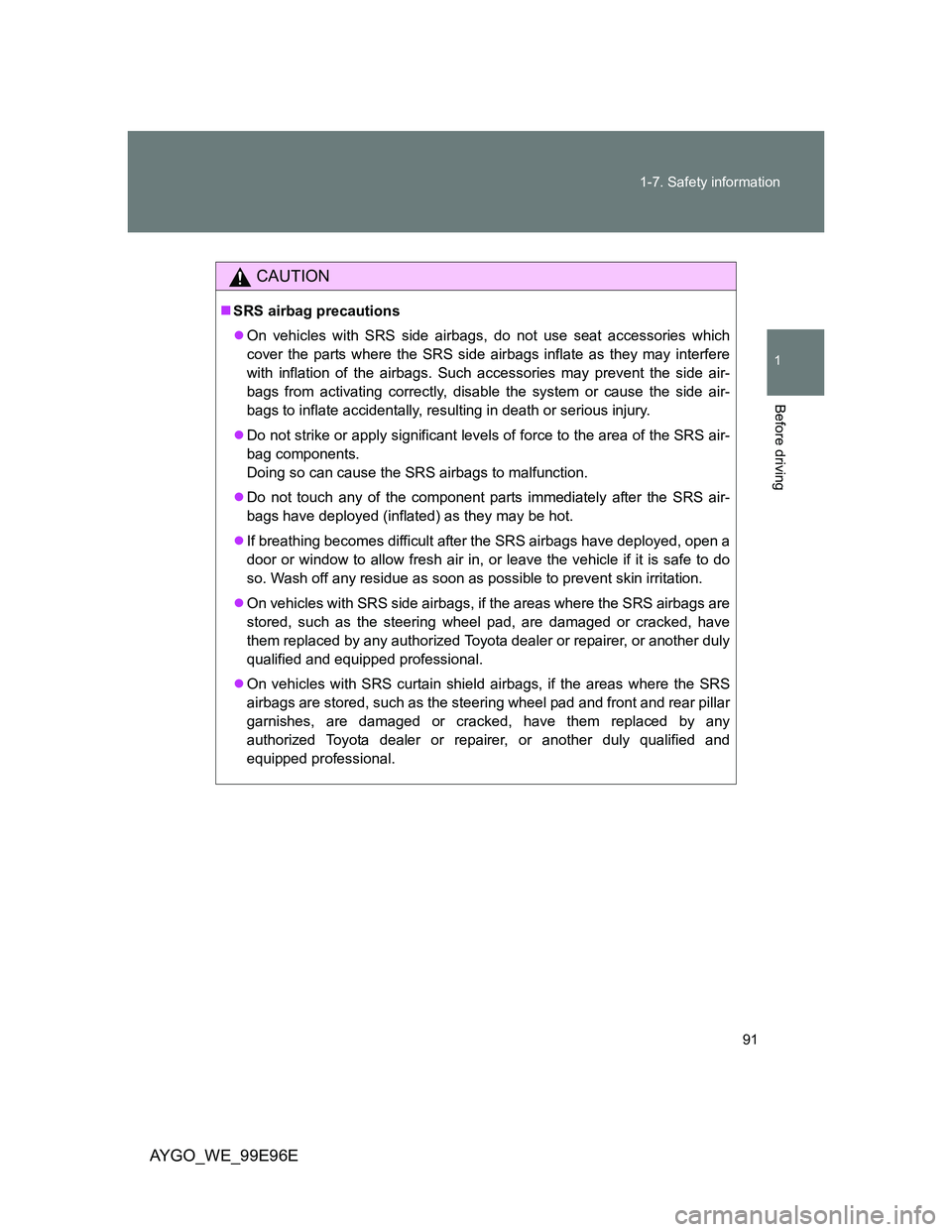
91 1-7. Safety information
1
Before driving
AYGO_WE_99E96E
CAUTION
SRS airbag precautions
On vehicles with SRS side airbags, do not use seat accessories which
cover the parts where the SRS side airbags inflate as they may interfere
with inflation of the airbags. Such accessories may prevent the side air-
bags from activating correctly, disable the system or cause the side air-
bags to inflate accidentally, resulting in death or serious injury.
Do not strike or apply significant levels of force to the area of the SRS air-
bag components.
Doing so can cause the SRS airbags to malfunction.
Do not touch any of the component parts immediately after the SRS air-
bags have deployed (inflated) as they may be hot.
If breathing becomes difficult after the SRS airbags have deployed, open a
door or window to allow fresh air in, or leave the vehicle if it is safe to do
so. Wash off any residue as soon as possible to prevent skin irritation.
On vehicles with SRS side airbags, if the areas where the SRS airbags are
stored, such as the steering wheel pad, are damaged or cracked, have
them replaced by any authorized Toyota dealer or repairer, or another duly
qualified and equipped professional.
On vehicles with SRS curtain shield airbags, if the areas where the SRS
airbags are stored, such as the steering wheel pad and front and rear pillar
garnishes, are damaged or cracked, have them replaced by any
authorized Toyota dealer or repairer, or another duly qualified and
equipped professional.
Page 92 of 368
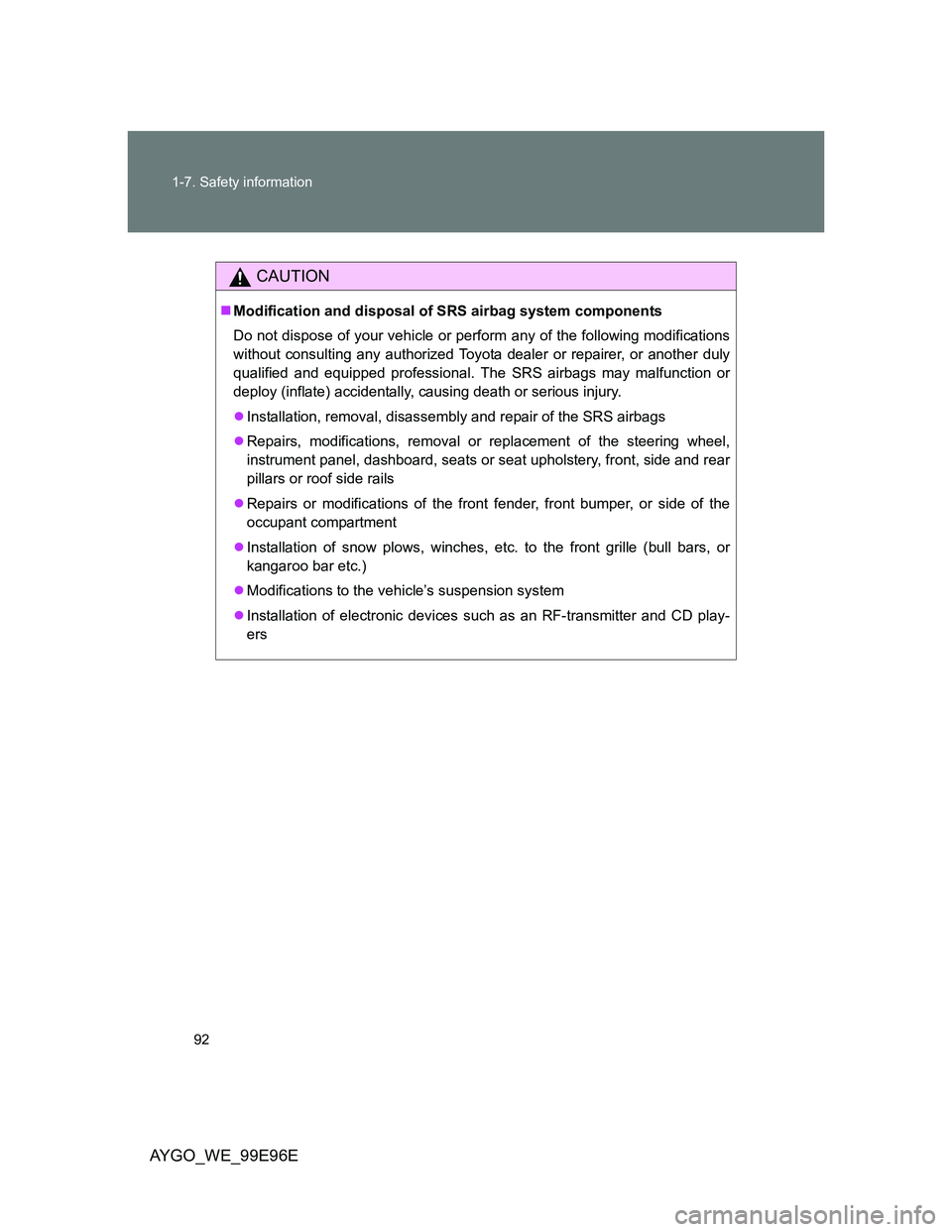
92 1-7. Safety information
AYGO_WE_99E96E
CAUTION
Modification and disposal of SRS airbag system components
Do not dispose of your vehicle or perform any of the following modifications
without consulting any authorized Toyota dealer or repairer, or another duly
qualified and equipped professional. The SRS airbags may malfunction or
deploy (inflate) accidentally, causing death or serious injury.
Installation, removal, disassembly and repair of the SRS airbags
Repairs, modifications, removal or replacement of the steering wheel,
instrument panel, dashboard, seats or seat upholstery, front, side and rear
pillars or roof side rails
Repairs or modifications of the front fender, front bumper, or side of the
occupant compartment
Installation of snow plows, winches, etc. to the front grille (bull bars, or
kangaroo bar etc.)
Modifications to the vehicle’s suspension system
Installation of electronic devices such as an RF-transmitter and CD play-
ers
Page 93 of 368
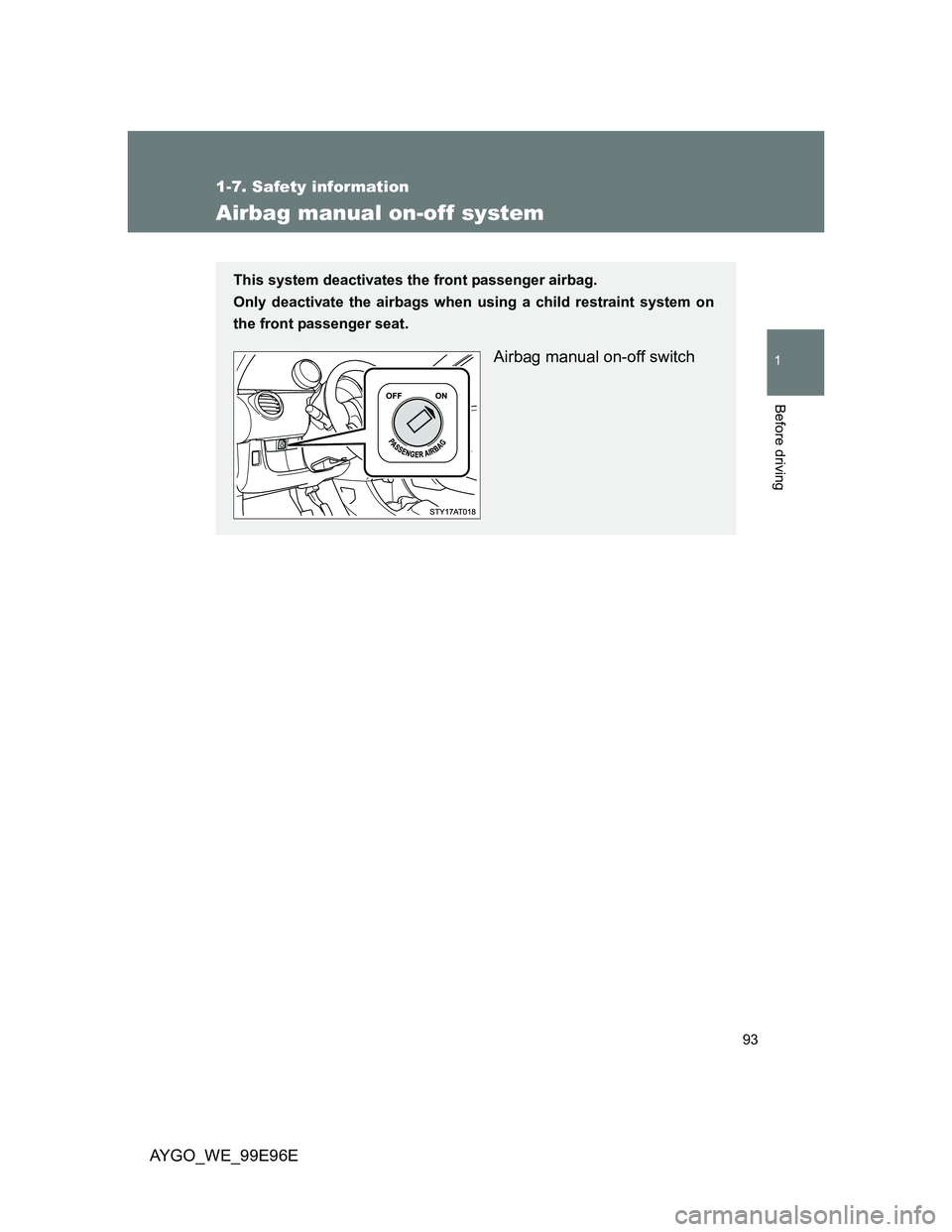
93
1
1-7. Safety information
Before driving
AYGO_WE_99E96E
Airbag manual on-off system
This system deactivates the front passenger airbag.
Only deactivate the airbags when using a child restraint system on
the front passenger seat.
Airbag manual on-off switch
Page 94 of 368
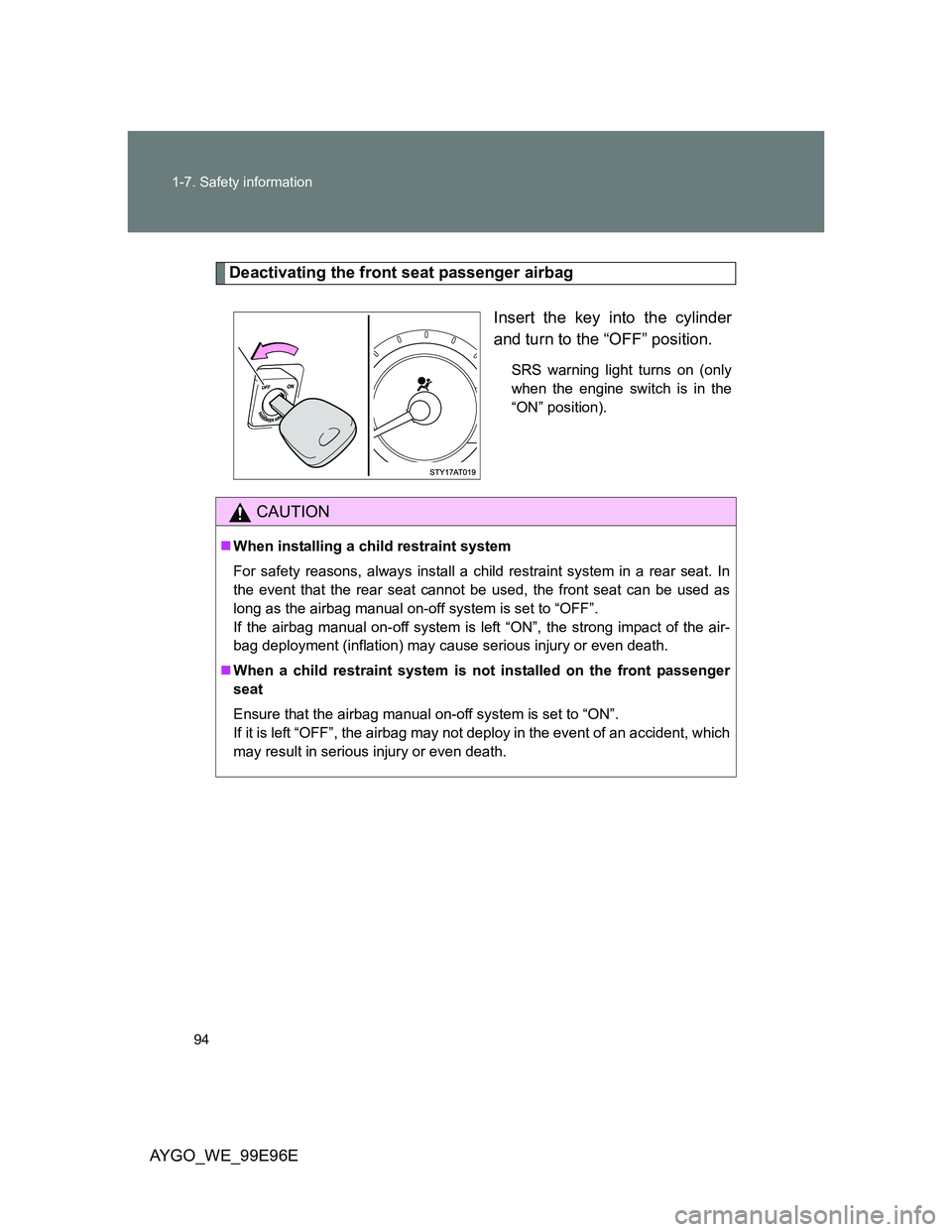
94 1-7. Safety information
AYGO_WE_99E96E
Deactivating the front seat passenger airbag
Insert the key into the cylinder
and turn to the “OFF” position.
SRS warning light turns on (only
when the engine switch is in the
“ON” position).
CAUTION
When installing a child restraint system
For safety reasons, always install a child restraint system in a rear seat. In
the event that the rear seat cannot be used, the front seat can be used as
long as the airbag manual on-off system is set to “OFF”.
If the airbag manual on-off system is left “ON”, the strong impact of the air-
bag deployment (inflation) may cause serious injury or even death.
When a child restraint system is not installed on the front passenger
seat
Ensure that the airbag manual on-off system is set to “ON”.
If it is left “OFF”, the airbag may not deploy in the event of an accident, which
may result in serious injury or even death.
Page 95 of 368
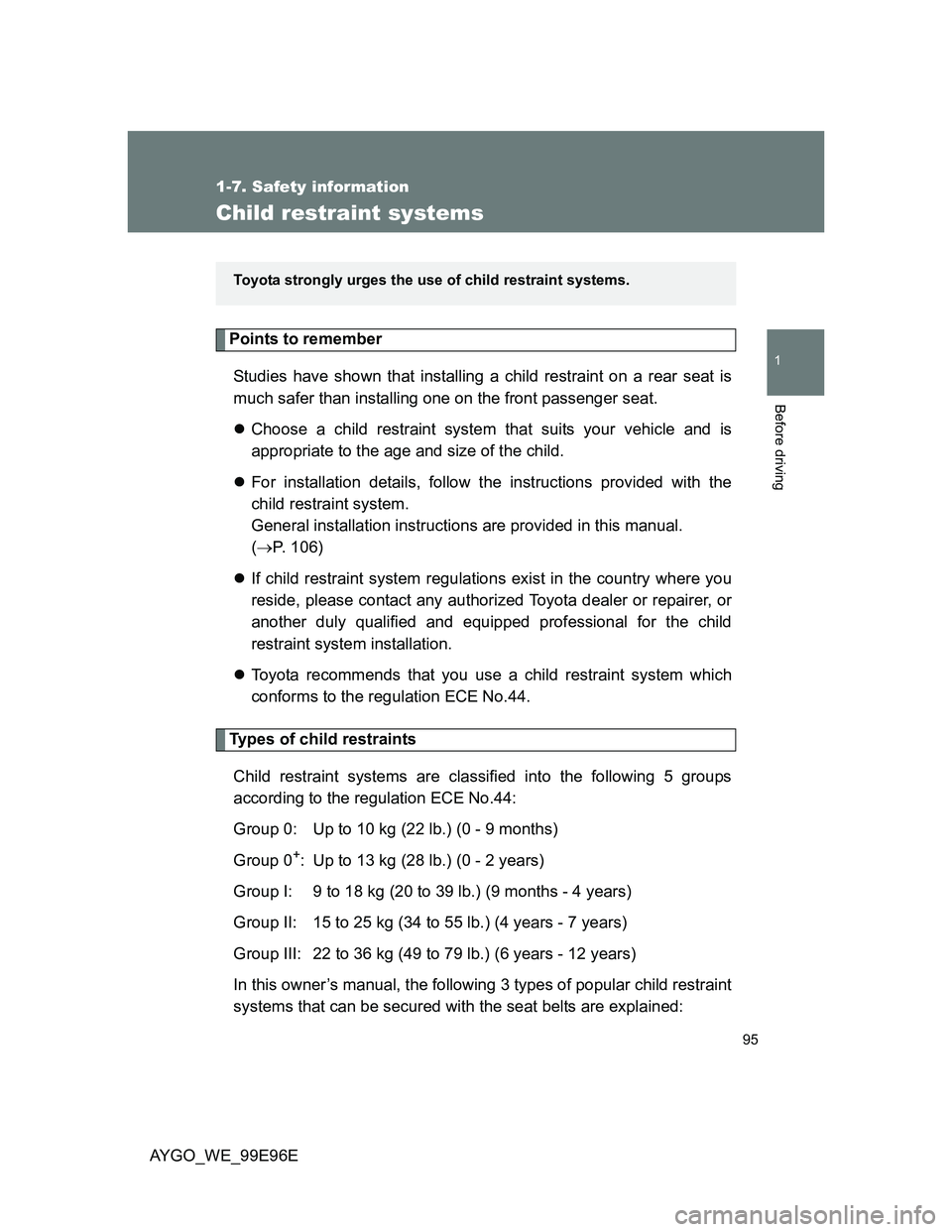
95
1
1-7. Safety information
Before driving
AYGO_WE_99E96E
Child restraint systems
Points to remember
Studies have shown that installing a child restraint on a rear seat is
much safer than installing one on the front passenger seat.
Choose a child restraint system that suits your vehicle and is
appropriate to the age and size of the child.
For installation details, follow the instructions provided with the
child restraint system.
General installation instructions are provided in this manual.
(P. 106)
If child restraint system regulations exist in the country where you
reside, please contact any authorized Toyota dealer or repairer, or
another duly qualified and equipped professional for the child
restraint system installation.
Toyota recommends that you use a child restraint system which
conforms to the regulation ECE No.44.
Types of child restraints
Child restraint systems are classified into the following 5 groups
according to the regulation ECE No.44:
Group 0: Up to 10 kg (22 lb.) (0 - 9 months)
Group 0
+: Up to 13 kg (28 lb.) (0 - 2 years)
Group I: 9 to 18 kg (20 to 39 lb.) (9 months - 4 years)
Group II: 15 to 25 kg (34 to 55 lb.) (4 years - 7 years)
Group III: 22 to 36 kg (49 to 79 lb.) (6 years - 12 years)
In this owner’s manual, the following 3 types of popular child restraint
systems that can be secured with the seat belts are explained:
Toyota strongly urges the use of child restraint systems.
Page 96 of 368
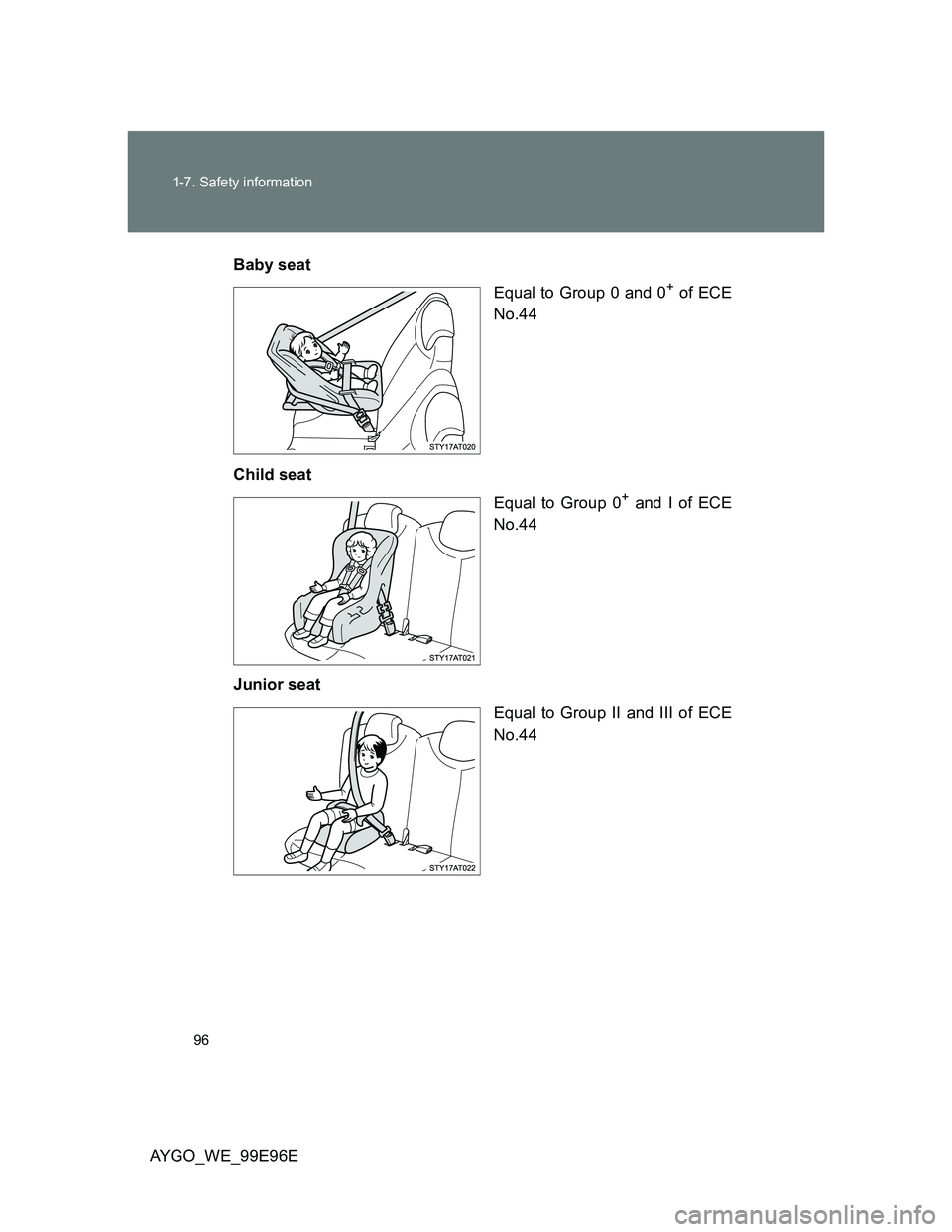
96 1-7. Safety information
AYGO_WE_99E96EBaby seat
Equal to Group 0 and 0
+ of ECE
No.44
Child seat
Equal to Group 0
+ and I of ECE
No.44
Junior seat
Equal to Group II and III of ECE
No.44
Page 97 of 368
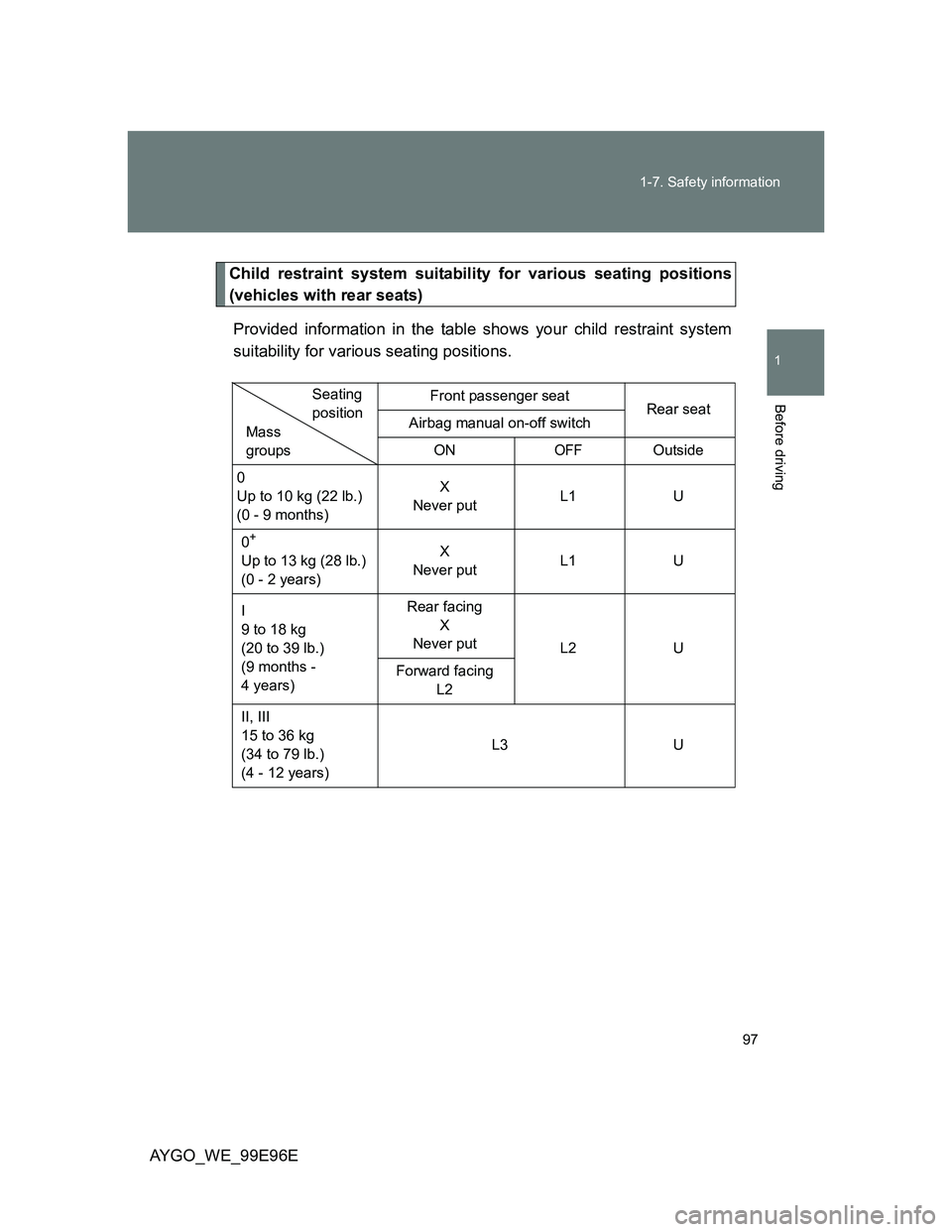
97 1-7. Safety information
1
Before driving
AYGO_WE_99E96E
Child restraint system suitability for various seating positions
(vehicles with rear seats)
Provided information in the table shows your child restraint system
suitability for various seating positions.
Front passenger seat
Rear seat
Airbag manual on-off switch
ON
OFFOutside
0
Up to 10 kg (22 lb.)
(0 - 9 months)X
Never putL1 U
0
+
Up to 13 kg (28 lb.)
(0 - 2 years)X
Never putL1 U
I
9 to 18 kg
(20 to 39 lb.)
(9 months -
4 years)Rear facing
X
Never put
L2 U
Forward facing
L2
II, III
15 to 36 kg
(34 to 79 lb.)
(4 - 12 years)L3 U
Mass
groupsSeating
position
Page 98 of 368

98 1-7. Safety information
AYGO_WE_99E96EKey letters inserted in the above table:
U: Suitable for “universal” category child restraint system approved
for the use in this mass group.
L1: Suitable for “TOYOTA BABY SAFE (0 to 13 kg [0 to 28 lb.])”
approved for the use in this mass group.
L2: Suitable for “TOYOTA DUO+ (without ISOFIX 9 to 18 kg [20 to
39 lb.])” approved for the use in this mass group.
L3: Suitable for “TOYOTA KID (15 to 36 kg [34 to 79 lb.])” approved
for the use in this mass group.
X: Not suitable seat position for children in this mass group.
The child restraint systems mentioned in the table may not be avail-
able outside of the EU area. Other child restraint systems which is dif-
ferent from the systems mentioned in the table can be used, but the
suitability of the systems must be carefully checked with the child
restraint system manufacturer concerned and the seller of those
seats.
Page 99 of 368

99 1-7. Safety information
1
Before driving
AYGO_WE_99E96E
Child restraint system suitability for various seating positions
(vehicles without rear seats)
Provided information in the table shows your child restraint system
suitability for various seating positions.
Front passenger seat
Airbag manual on-off switch
ON
OFF
0
Up to 10 kg (22 lb.)
(0 - 9 months)X
Never putL1
0
+
Up to 13 kg (28 lb.)
(0 - 2 years)X
Never putL1
I
9 to 18 kg (20 to 39 lb.)
(9 months - 4 years)Rear facing
X
Never put
L2
Forward facing
L2
II, III
15 to 36 kg (34 to 79 lb.)
(4 - 12 years)L3
Mass
groupsSeating
position
Page 100 of 368
![TOYOTA AYGO 2012 Owners Manual (in English) 100 1-7. Safety information
AYGO_WE_99E96EKey letters inserted in the above table:
L1: Suitable for “TOYOTA BABY SAFE (0 to 13 kg [0 to 28 lb.])”
approved for the use in this mass group.
L2: Suita TOYOTA AYGO 2012 Owners Manual (in English) 100 1-7. Safety information
AYGO_WE_99E96EKey letters inserted in the above table:
L1: Suitable for “TOYOTA BABY SAFE (0 to 13 kg [0 to 28 lb.])”
approved for the use in this mass group.
L2: Suita](/img/14/48366/w960_48366-99.png)
100 1-7. Safety information
AYGO_WE_99E96EKey letters inserted in the above table:
L1: Suitable for “TOYOTA BABY SAFE (0 to 13 kg [0 to 28 lb.])”
approved for the use in this mass group.
L2: Suitable for “TOYOTA DUO+ (without ISOFIX 9 to 18 kg [20 to
39 lb.])” approved for the use in this mass group.
L3: Suitable for “TOYOTA KID (15 to 36 kg [34 to 79 lb.])” approved
for the use in this mass group.
X: Not suitable seat position for children in this mass group.
The child restraint systems mentioned in the table may not be avail-
able outside of the EU area. Other child restraint systems which is dif-
ferent from the systems mentioned in the table can be used, but the
suitability of the systems must be carefully checked with the child
restraint system manufacturer concerned and the seller of those
seats.